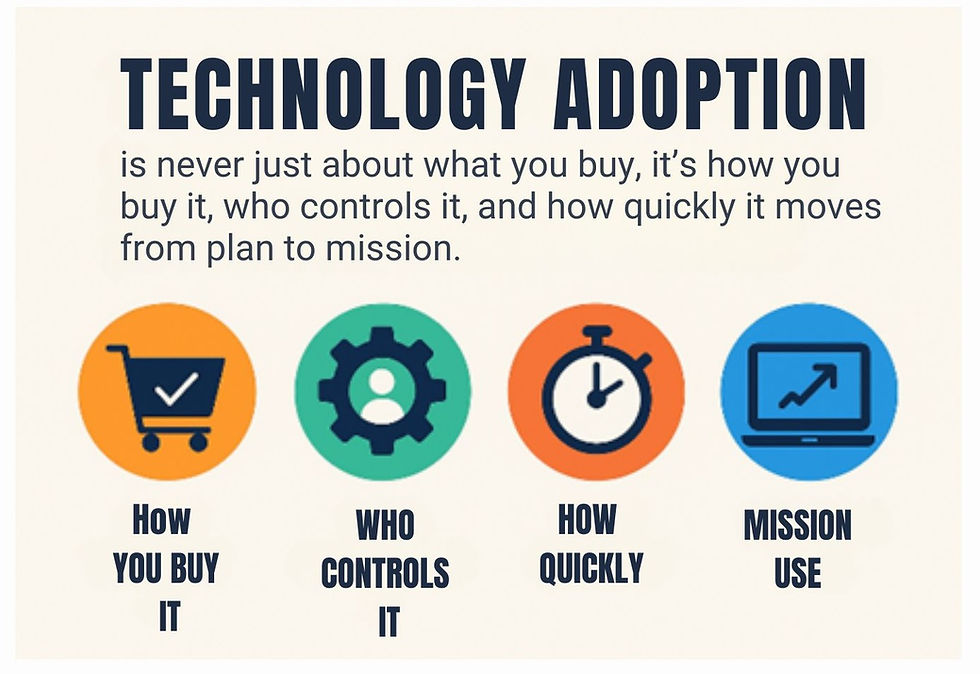Fast-Tracking AI: OMB’s April 3 Memo to Revolutionize Federal Acquisition
- Sai Sravan Cherukuri
- Aug 12
- 3 min read

BLUF: Federal AI acquisition is a critical opportunity to proactively shape your agency’s AI future, prioritizing control, trust, and mission readiness through a foundation of transparency, flexibility, and responsible governance.
The Office of Management and Budget (OMB), through its April 3, 2025, memo “Driving Efficient Acquisition of Artificial Intelligence”, has set a high-stakes timeline for agencies to align acquisition processes with new AI standards. The goal is clear: to build a competitive American AI marketplace while safeguarding public trust, protecting data rights, and accelerating responsible adoption.
The Countdown to October 20
By October 20, federal agencies must update their internal policies to standardize the treatment of data ownership and intellectual property (IP) rights in AI procurements. These updates must spell out:

Who owns the AI model developed or customized under the contract
Who controls the datasets used for training and fine-tuning
How data will be stored, shared, and secured throughout the AI lifecycle
These clarifications determine whether agencies can adapt, scale, or transfer AI capabilities without being locked into a single vendor’s proprietary ecosystem.
By the end of 2025, agencies will also need to align their entire acquisition process with OMB’s guidance. That means:
Pre-acquisition reviews to evaluate AI performance and risk management practices
Establishing a cross-functional AI acquisition review team with cybersecurity, legal, data, and mission experts
Embedding IP rights protections into every AI contract and solicitation
A Government-Wide Knowledge Hub
To support these efforts, the General Services Administration (GSA) has its own October 20 deadline for launching an online portal where agencies can share:
Sample solicitations and standard AI contract clauses
Pre-negotiated costs for common AI tools
Case studies and best practices from successful AI deployments
This portal is intended to be more than a resource library; it’s a collaborative playbook for federal AI procurement.
The IP and Data Privacy Puzzle-Understanding the ownership chain in AI is critical.
“How is the solution provider using your data to train the model? Who owns the model at that point, and who owns the datasets? Because that entire process can become proprietary.”
For agencies, the risk is clear: without strong IP clauses and data use restrictions, they could inadvertently hand over long-term control of valuable assets.
The solution? Early and informed negotiation between industry and government to design IP protections and privacy safeguards that hold up over the full lifecycle of AI use.

Beyond Procurement: Removing Barriers to AI Maturity
In a companion April 3 memo, OMB directs agencies to:
Identify and eliminate obstacles to responsible AI adoption
Strengthen enterprise-wide AI maturity
Focus risk management on “high impact” AI use cases
Require pre-deployment testing and AI impact assessments for those cases
These measures force agencies to look beyond the buying stage, ensuring AI systems are mission-aligned, secure, and adaptable before they’re deployed.
The Role of Chief AI Officers and Cross-Functional Teams
OMB also formalizes a leadership role for Chief AI Officers, who will steer agency compliance and strategy. It’s really about assessing viability against the mission, understanding model capabilities, avoiding vendor lock-in, and addressing public privacy, all before acquisition.
That means bringing together cybersecurity specialists, data scientists, legal counsel, procurement officers, and mission owners into one AI governance body. This group must weigh:
Threat vectors from emerging AI attack surfaces
Relevant NIST standards and frameworks
Insights from federal research labs and field tests
The contractual details that lock in or preserve long-term flexibility
The Stakes Are High and the Timeline is Short
AI innovation is moving at an exponential pace. Ideas that seemed impossible just a year ago are now becoming reality. In this kind of environment, standing still isn’t an option.
Agencies that act quickly, aligning their acquisition policies and building strong, cross-functional governance teams, will not only meet OMB’s deadlines. They’ll be at the forefront of AI innovation, delivering better results for their missions and creating real impact for the people they serve.








